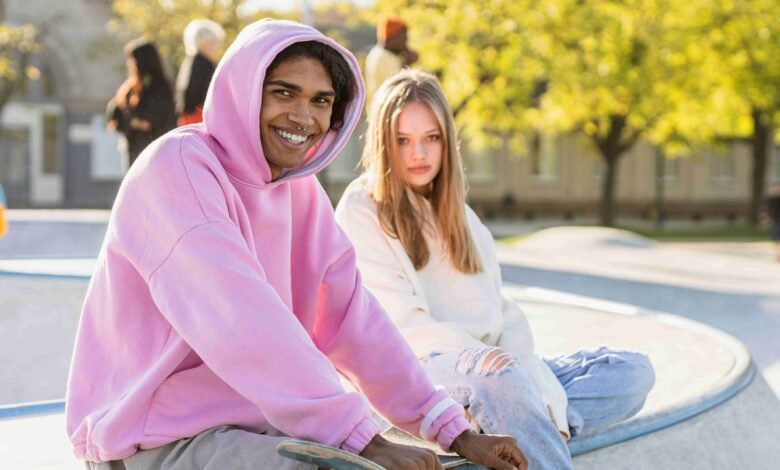How to Tie a Hoodie on Waist Fashionably

Add an air of luxury and sophistication to your outfit by tying a hoodie around your waist for an eye-catching look that works for formal as well as casual occasions – a particularly fashionable style in colder climates.
Hoodies are casual clothing items featuring a hood that can be pulled over the head to cover head coverage. Common materials for these garments include cotton or fleece fabric; pullover or zipper up options may also exist.
Hoodies are versatile
Hoodies are among the most versatile pieces of clothing, as they can be worn year-round. Lighter fabrics work best in spring and summer months while thicker materials provide warmth in fall and winter months. Hoodies also remain comfortable to wear even during hotter temperatures, making them suitable for shopping trips, hiking excursions or workout sessions alike. Hoodies come in an assortment of colors, designs and styles suitable for men and women – easily pairing well with casual clothing such as jeans yet dressy enough for formal events as well.
Hoodies have quickly become an essential element of streetwear and are frequently associated with youth culture, creativity and nonchalant style. Hoodies can be combined with cargo pants and backpack for a trendy look or worn with relaxed denim for more relaxed occasions; bold accessories add visual interest while Hoodies also serve as great promotional vehicles that can feature your business logo or slogan to advertise products!
Hoodies’ unisex nature provides another advantage; eliminating gender-specific designs and encouraging inclusivity through fashion. Plus, their accessibility and cost make them great choices for people on a tight budget; with plenty of styles and colors to choose from there’s sure to be one perfect for every taste!
They are easy to wear
Men’s hoodies offer almost limitless possibilities when it comes to selection. From subtle colors that complement your outfit or bold hues with logos, there is something suitable for every taste – though for maximum longevity and versatility it is wiser to opt for neutral tones as this will allow the piece to coordinate better with various ensembles without quickly dating itself out of fashion.
Hoodies were once solely associated with hip-hop culture and heavy metal subculture; today however, they’ve witnessed an extraordinary renaissance due to changing fashion attitudes and an appreciation of versatile clothes which can be worn casually across various settings.
Hoodies can be styled with many types of clothing, from jeans and joggers to layering them under jackets. When pairing your hoodie with jeans, be sure to choose slim-fit joggers or skinny jeans to prevent too bulky an appearance; adding box-fresh sneakers can take this look one step further.
Wear a classic winter look when pairing a hoodie and flannel shirt, but avoid patterns or brightly-coloured hoodies as these could clash with its neutral tones. Complete the ensemble by accessorizing with either earmuffs or straw hat.
They are comfortable
Hoodies have quickly become an indispensable part of everyday wardrobes. Hoodies make the ideal companion when lounging around the house, running errands or heading off to the gym – plus they’re comfortable enough to wear while working or watching movies! Hoodies come in an assortment of styles and colors to suit any special event or casual gathering.
Hoodies were originally designed by Champion to keep warehouse workers warm; today they’re worn by celebrities, athletes, musicians and fashion industry insiders alike. Hoodies’ popularity has helped drive fashion forward, setting trends and inciting other brands to produce them; these timeless yet trendy pieces never go out of style!
The best hoodies are constructed from fabrics that provide maximum comfort while being easy to care for, like cotton or fleece hoodies, while synthetic fabrics like polyester can be lightweight yet breathable. Find one that meets the needs of your customers to ensure they enjoy wearing their hoodie for many years to come!
Hoodies are an effective way of advertising and increasing customer loyalty. Hoodies can be customized with your own designs to make them truly stand out among competitors – great choice for businesses of any size and available in an extensive selection of sizes suitable for men and women alike.
They are versatile
Hoodies have become an indispensable component of modern wardrobes. Their adaptable nature allows them to adapt seamlessly to a range of styles and occasions – you can dress one up with leather jacket or blazer or wear it casually under denim jacket for a chic casual look. Black hoodies make an elegant minimalist statement while pastel hues give more polished ensembles the added polish they require.
Hoodies’ transformation into fashion icons is indicative of shifting lifestyle preferences and attitudes, and an embracement of versatile functional fashion. This trend has given birth to an entirely new generation of style and clothing designs that connect diverse cultural and aesthetic preferences.
No matter the occasion, hoodies make for the ideal go-to choice, be it at the gym or simply hanging out with friends. From casual outfits like jeans or joggers to dressed up options like boots or loafers – they make for great travel accessories that can turn six hours of airport boredom into an enjoyable journey.
Hoodies are versatile garments, perfect for wearing throughout the year. Lighter fabric hoodies make an excellent statement piece in spring and summer months; while thicker versions provide warmth in autumn and winter. Hoodies can even be layered under jackets for additional warmth or worn over T-shirts for an eye-catching, fashionable look.




